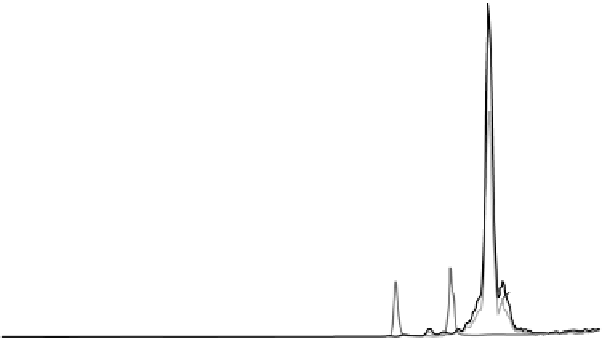Chemistry Reference
In-Depth Information
1: SIR of 2 Channels ES+
TIC
8.40e6
1.63
1.68
0
0.00
0.10
0.20
0.30
0.40
0.50
0.60
0.70
0.80
0.90
1.00
1.10
1.20
1.30
1.40
1.50
1.60
1.70
1.80
1.90
2.00
Time
FIgure 7.14
Example UHPLC/MS analysis of an extracted cleaning swab samples. Figure
shows an overlay of a separation of two APIs, and two swab extracts using different extraction
solvents. A reversed-phase separation with a 2.1 by 50-mm C18 column and a formic acid/
acetonitrile gradient was used, with single quadrupole MS detection in single ion recording
mode (two channels). The peaks at 1.3 and 1.5 min are from the APIs of interest; the large
peaks at 1.6 min are from the swab.
validation place great demands on the sensitivity of the analytical technique used.
For this reason, increasingly more sensitive detection techniques are required, and
Figure 7.14 shows an approach using single quadrupole UHPLC/MS detection nec-
essary to provide the requisite sensitivity.
Many companies are experimenting with new technology and methods, espe-
cially given today's more potent and complex biotechnology-derived therapeutics.
Emerging trends include more specific assays, compound-specific (instead of whole-
product) cleaning protocols, and increased automation. In addition, many companies
have modified or are moving away from the use of cleaning agents. Aqueous-based
cleaning agents free of organic solvents (or even hot water alone) have become more
prevalent. Pressurized rinsing, visualization with fiber optics and video cameras,
and more specific and sensitive detectors for residue assay methods are also being
explored.
By knowing the product, the process, and the ingredients used and their proper-
ties, a greater probability of success is all but guaranteed.
7.8 conclusIon
The degree, amount, or level of method validation depends on the type of method,
its intended use, and the phase of development. The type of method or procedure
and its intended use dictate which performance characteristics must be evaluated;
the phase of development dictates the amount, or in some cases the level of scrutiny



